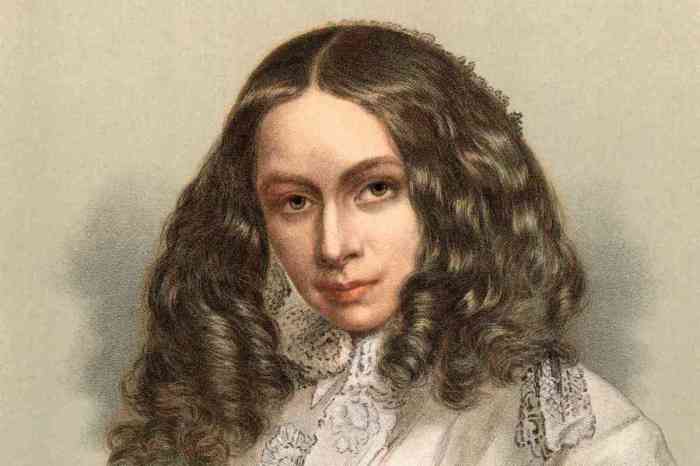Elizabeth barrett browning sonnet 13 – Elizabeth Barrett Browning’s “Sonnet 13” stands as a testament to the power of love, longing, and mortality. This sonnet, published in 1850, has captivated readers with its exquisite language and profound exploration of the human condition.
Within its traditional sonnet form, Barrett Browning weaves together a tapestry of emotions, employing rich imagery and symbolism to convey the speaker’s innermost thoughts and feelings.
Introduction
Elizabeth Barrett Browning’s “Sonnet 13” holds a significant position within her body of work, reflecting her profound exploration of love, spirituality, and personal growth.
Published in 1850 as part of her collection “Sonnets from the Portuguese,” this sonnet has garnered critical acclaim for its passionate and introspective portrayal of romantic love.
Publication History and Reception
Upon its initial publication, “Sonnet 13” was widely praised for its lyrical beauty and emotional depth. Critics lauded Barrett Browning’s skillful use of language and imagery, which vividly conveyed the complexities of human emotions.
Over time, the sonnet has become one of the most celebrated works in the English language, consistently included in anthologies and studied in academic settings.
Structure and Form
Elizabeth Barrett Browning’s Sonnet 13 exhibits a traditional Petrarchan sonnet structure, consisting of an octave (eight lines) followed by a sestet (six lines). The octave presents a problem or question, while the sestet offers a resolution or answer.
Rhyme Scheme
The sonnet employs an ABBA ABBA CDECDE rhyme scheme. This intricate pattern creates a sense of unity and cohesion within the poem, linking the lines together and enhancing its musicality.
Meter
The sonnet is written in iambic pentameter, a rhythmic pattern consisting of five pairs of unstressed and stressed syllables per line. This meter lends a stately and dignified tone to the poem, reflecting the elevated emotions and themes it explores.
Impact of Form
The sonnet’s structure and form contribute significantly to its meaning and impact. The octave’s question or problem establishes a sense of tension and anticipation, which is then resolved in the sestet’s answer or solution. This structure mirrors the emotional journey of the speaker, who grapples with complex emotions and ultimately finds solace in love.
Themes and Imagery
Elizabeth Barrett Browning’s “Sonnet 13” delves into the profound themes of love, longing, and mortality. The poet employs vivid imagery and symbolism to convey these complex emotions and ideas.
Love
- The sonnet celebrates the speaker’s intense love for her beloved, expressing the transformative power of love.
- Browning uses the metaphor of “sunbeams” to symbolize the illuminating and uplifting nature of love.
- The speaker’s love is described as “everlasting,” transcending the boundaries of time and mortality.
Longing, Elizabeth barrett browning sonnet 13
- The sonnet captures the speaker’s longing for her beloved when they are apart.
- Browning employs the image of “wandering thoughts” to convey the restless and yearning nature of longing.
- The speaker’s longing is characterized by both pain and anticipation, as she desires to be reunited with her beloved.
Mortality
- The sonnet acknowledges the inevitability of death and the brevity of life.
- Browning uses the metaphor of “shadow” to symbolize the constant presence of mortality.
- Despite the awareness of mortality, the speaker finds solace in the enduring power of love, which transcends the physical realm.
Language and Style

The language and style of Elizabeth Barrett Browning’s Sonnet 13 are notable for their richness, complexity, and emotional intensity. Browning employs a variety of literary devices, including vivid imagery, evocative diction, and complex syntax, to create a poem that is both beautiful and thought-provoking.
Diction
Browning’s diction is characterized by its use of both common and elevated language. She uses simple, everyday words to convey her emotions and experiences, but she also employs more formal and poetic language to create a sense of beauty and grandeur.
For example, in the opening lines of the sonnet, she describes her love as “a fever of the mind,” using a metaphor that compares the intensity of her love to a physical illness.
Syntax
Browning’s syntax is also complex and varied. She uses a variety of sentence structures, including long, flowing sentences and short, clipped phrases. This variation in syntax helps to create a sense of rhythm and movement in the poem. For example, in the following lines, Browning uses a series of short, clipped phrases to convey the intensity of her love:
I love thee with a passion put to useIn my old griefs, and with my childhood’s faith.
Tone
The tone of Sonnet 13 is passionate, intense, and deeply personal. Browning’s language and style convey a sense of urgency and longing, as she expresses her love for her beloved. The poem is also marked by a sense of vulnerability and intimacy, as Browning reveals her innermost thoughts and feelings.
Historical and Cultural Context: Elizabeth Barrett Browning Sonnet 13

Elizabeth Barrett Browning’s “Sonnet 13” was composed during the Victorian era, a period of significant social and intellectual transformation. The sonnet reflects the cultural climate of its time in several ways.
Social and Intellectual Climate
The Victorian era was characterized by a complex interplay of social and intellectual currents. Industrialization and urbanization led to profound changes in society, including the rise of a middle class and the expansion of educational opportunities for women. At the same time, there was a strong emphasis on domesticity and gender roles, with women expected to conform to traditional ideals of femininity.
Intellectually, the Victorian era was marked by a fascination with science and rationalism. The publication of Charles Darwin’s On the Origin of Speciesin 1859 challenged traditional religious beliefs and sparked widespread debate about the nature of human existence. However, despite these intellectual advancements, Victorian society also held conservative values and a strong adherence to social conventions.
Sonnet 13 and its Reflection of the Time
“Sonnet 13” reflects the social and intellectual climate of the Victorian era in several ways. The sonnet’s focus on the speaker’s longing for a love that transcends societal constraints speaks to the tensions between personal desire and social expectations that were prevalent during this time.
Additionally, the sonnet’s use of scientific imagery, such as the comparison of the speaker’s love to a “star” and a “planet,” suggests an engagement with the intellectual currents of the era.
However, the sonnet also departs from Victorian conventions in its exploration of female agency and desire. The speaker’s bold declaration of her love and her refusal to conform to traditional gender roles challenge the prevailing social norms of the time.
Comparison and Contrast
Elizabeth Barrett Browning’s “Sonnet 13” stands out among her other sonnets and the wider sonnet tradition through its unique combination of themes, style, and impact.
Compared to Browning’s earlier sonnets, “Sonnet 13” exhibits a greater maturity and depth of emotion. While her early sonnets often explored themes of love and longing, “Sonnet 13” delves into more complex and introspective territory, examining the nature of the poetic voice and the challenges of artistic creation.
In terms of style, “Sonnet 13” is characterized by its use of enjambment and irregular rhyme scheme. These techniques create a sense of fluidity and movement that mirrors the speaker’s own restless and searching mind.
Compared to sonnets by other poets, “Sonnet 13” stands out for its distinctly feminine perspective. While many sonnets written by men explore themes of love and desire from a masculine point of view, Browning’s sonnet offers a unique insight into the female experience of love and creativity.
Ultimately, “Sonnet 13” is a powerful and moving exploration of the complexities of the poetic voice and the challenges of artistic creation. Through its unique combination of themes, style, and impact, it has secured its place as one of the most significant sonnets in the English language.
Critical Reception
Elizabeth Barrett Browning’s “Sonnet 13” has received critical acclaim over time, with scholars and literary enthusiasts alike praising its lyrical beauty, emotional depth, and exploration of complex themes.
Early critics lauded the sonnet’s use of imagery and metaphor, particularly its depiction of the speaker’s love as a “bower of dreams.” Victorian critic William Michael Rossetti praised the sonnet’s “richness of imagery and deep passion.”
Modern Interpretations
Modern critics have continued to appreciate the sonnet’s artistry, while also offering new interpretations. Some scholars have focused on the sonnet’s exploration of gender roles and the speaker’s desire for autonomy. Others have examined the sonnet’s connection to the Romantic movement and its emphasis on nature and emotion.
Evaluations
Overall, “Sonnet 13” is considered one of Elizabeth Barrett Browning’s finest works. Its lyrical beauty, emotional depth, and exploration of complex themes have made it a beloved poem among readers and critics alike.
Commonly Asked Questions
What is the rhyme scheme of “Sonnet 13”?
ABAB CDCD EFEF GG
What is the central theme of “Sonnet 13”?
The power of love to transcend the boundaries of life and death
How does Barrett Browning use imagery in “Sonnet 13”?
She employs imagery of light and darkness, flowers, and the sea to convey the emotions of love and longing

